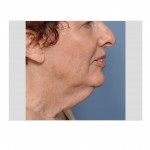Background:Changes in the neck is one of the most bothersome facial changes that occurs as one ages. A sagging neck can ‘grow’ into a really significant neck wattle by the time one reaches their sixties and seventies. When the neck sags to this degree, it literally flops from side to side and hangs down from the chin all the way to below the thyroid cartilage. (adam’s apple) This neck wattle is often referred to as a ‘turkeyneck’.
The traditional treatment for any sagging neck problem is that of a facelift. The benefits to the neck in a facelift is that the hanging skin is freed and chased back to the ears where it can be removed and the resultant scars placed in the hidden crevices and skin folds of the ear. While this is a highly successful operation, certain patients may seek an alternative approach that is less extensive , more cost effective and has a quicker recovery.
This alternative approach is the direct necklift. While uncommonly done, it removes the neck wattle by directly cutting it out. The tradeoff for this more simpler neck solution is that of a scar running down the center of the neck. This scar in the older male usually does quite well because of its location in bearded skin. The hair follicles in the skin and the daily use of shaving (microdermabrasion) leads to good scar outcomes. Women, however, have a different quality of neck skin that is usually thinner and the creation of a neck scar is more of a potential concern.



The skin edges from the sides of the neck are then brought together in the midline after first bringing together the horizontal areas under the chin and low in the neck above the sternal notch. The deeper layers are closed with resorbable sutures while the skin is closed with sutures that will need to be removed a week later. The only dressing that is used are small tapes which are glued on over the stitches. There are no restrictions after surgery including showering the very next day.

Case Highlights:
|
|
|
|
1) The direct necklift is a good option for the older woman with a significant neck wattle if one can accept the trade-off of amidline neck scar.
2) The direct necklift provides a dramatic tightening of the neck angle through platysmal muscle tightening and generous removal of the hanging neck wattle.
3) Widening and tightness of the central position of the midline neck scar may require revision through a simple z-plasty or steroid injections.
Dr. Barry Eppley
Indianapolis Indiana


